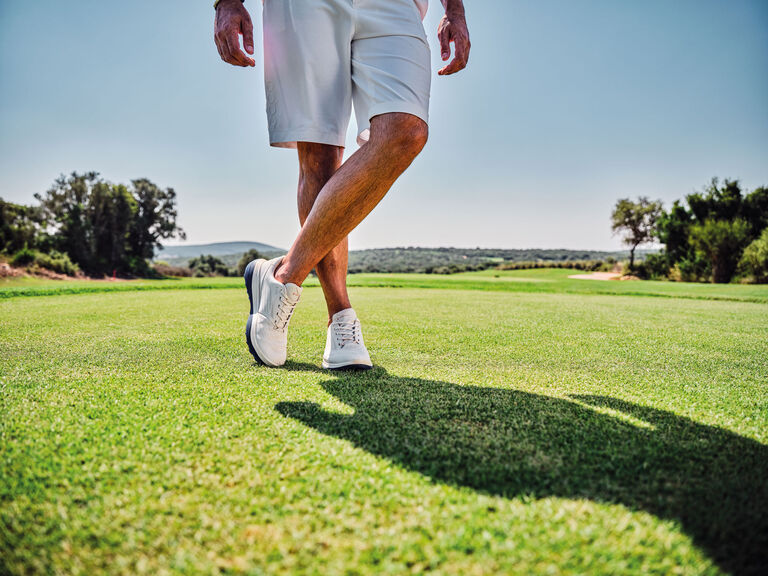Golf shoes: how to pick the right ones
15 March 2024

How to find the perfect shoe
Functional membranes and cushioning systems, packaged in stylish looks characterize the range of golf shoes. We have some tips on how to find the perfect golf shoe for you. And: we'll be looking into the question of whether you can gain club head speed and save strokes with the right footwear?
"A golf shoe that can take every swing in every position in every season." This is an advertising slogan that seems to fit some of the top models on the golf shoe market. Another even promises an additional gain in club head speed and shot length and, as a result, an improvement in round results. Dreams of the future?
Some golfers may still remember the days when pure leather and metal spikes (later with ceramic tips) dominated heavyweight shoes on the fairways. Warning signs on the clubhouse doors that demanded “please change your footwear” before entering. Because golf shoes destroyed the wooden and carpeted floors and posed a high risk of slipping and injury on the tiles in the changing rooms. After long days of play, the greens also looked pretty devastated, and desperate greenkeepers had their hands full with nasty spike marks and furrows made by shuffling golfers.
Fortunately, these scenarios are a thing of the past. Drivers with carbon club faces and more than 10,000 MOI, mallet putters produced with artificial intelligence - and the highest level of high-tech in footwear. Nowadays, golf shoes are designed for high-performance sport across the board. Modern golfers play their rounds in shoes with breathable and waterproof membranes, cushioning systems adapted to the strain of long foot marches and explosive swings, stabilization supports and elements that support golf-specific movement. With a total weight that is a fraction of the models from 30 years ago. Everything at the highest level – the only question remaining is how to find the perfect golf shoe for you. For there are major differences that can prove an advantage or disadvantage, depending on your preferences.
Golf shoes with or without spikes?
Fred Couples really made casual sneakers socially acceptable on the golf course in 2010 when he casually walked the fairways of Augusta in his Eccos and, at the age of 50, led the Masters Tournament with a round of 66. While his competitors were all looking up at Couples, everyone else seemed to be looking down. "I get more attention for my shoes than my pars and birdies," Couples said, recalling the spikeless pair of Eccos he wore that week - without socks, mind you. "Fred Couples Golf shoes" was the fourth most searched term on Google this Masters week. The 1992 Masters winner, former world number one and casual long-hitter known by the nickname Boom Boom Freddy, finished sixth 14 years ago and the Danish shoe manufacturer's warehouses were empty overnight.
A fond memory and the beginning of a new era of casual, comfortable leisure shoes on the golf course. Clear advantage: a particularly comfortable shoe for all "life situations". Disadvantage: more risk of slipping, less grip, tends to transfer less energy. One solution could be shoe fittings and tests on force plates. Or you resort to the two-millimeter thin BAL.ON insoles with pressure sensors, providing artificial intelligence, swing analysis and instant feedback. Based on sound data, you can then weigh up whether maximum energy transfer, functionality or comfort are more important to you and find the optimal mix and the perfect model for you.
Health aspect: What makes a good golf shoe?
Golf legend Bernhard Langer tore his Achilles tendon in the gym at the beginning of 2024. This is the most common tendon rupture in the human body. "The Achilles tendon is the strongest tendon and works like a spring: if it is overstretched, it ruptures," explains the physiotherapist for the European Ryder Cup team, Artur Frank. "As prevention, you should stretch the Achilles tendon well, treat the fascia, wear good sports shoes and insoles if necessary," the expert continues. Golfers can therefore take preventative measures with a suitable shoe, among other things.
Various scientific studies have shown that providing feet with cushioning comfort insoles in a sensible golf shoe leads to clear improvements. "It doesn't matter whether there is an orthopaedic foot deformity or not," says Frank. The decisive factor is that the insole supplied can be removed if the golfer needs an orthopaedic insole. "Comfort and fit are the most important criteria when buying a golf shoe." It is important to ensure that certain manufacturers offer different widths as well as modern materials that are breathable and water-repellent. Equally important: good heel guidance thanks to a stable heel cap and flex zones so that it can adapt to different terrains.
Good golf shoes are also characterized by low weight, suitable midsole materials to dampen unwanted vibrations so that the golfer has to use less muscle power, as well as an increase in the flexural rigidity of the shoe midsoles to reduce the energy loss at the base of the toe joint during the rolling phase. In summary some essential criteria for shoe comfort in your search for the perfect golf shoe: no pain, perfect fit, stability, cushioning, antomic features, foot climate.

